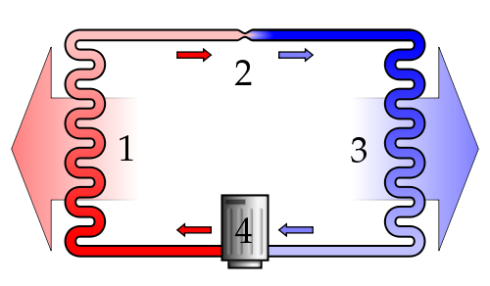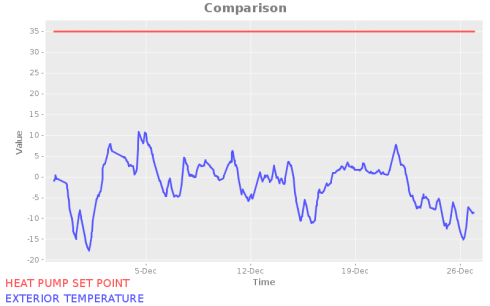How heat pump works
Heat pumps are quite different from other heating devices: contrary to them, the heat they produce is a by-product, rather than the main heat source.
Take an electric heater for example. It consumes electricity to produce heat directly. A heat pump will use this electricity to move the heat from a place to another. What’s the difference? Well it turns out that it’s cheaper to move heat than to create it. For the same amount of electricity required to produce 1kW of heat, you could move 7kW. (Of course this can vary greatly depending on a variety of factors.)

A heat pump takes heat from a place and move it to another (thus there’s always a hot side and a cold side)
If I were to put in sentimental terms, I would say that using electricity to produce heat is one of the stupidest and wasteful way to use electricity. Moving heat is far more intelligent.
Heat pump controls
Transferring heat from one place to another requires some work. The bigger the temperature difference between the two places, the more work it requires.
You could see it as moving dirt using a wheelbarrow. The temperature difference in this case would be the height difference. To take heat (wheelbarrow) from a cold place (low ground), you would have to push it to the hot place (high hill). The hotter the destination, the higher the hill.
Knowing this, to expand the least amount of energy possible, you would want to find the lowest possible hill to dump your dirt. In other words, you want your heat pump to work at a minimum temperature differential.

To accelerate heat transfer however, you must increase the temperature difference. The heat transfer is proportional to the temperature differential squared. This means that in order to keep a room warm in the cold months of winter, you might have to increase your heater set point to a higher temperature.
Let’s sum this up in those 2 following points:
- For optimal efficiency, always seek the lowest temperature differential;
- To increase heat transfer, you have to increase the temperature differential.
Thus, we can see that the optimal way to control a heat pump is to always try to use the lowest temperature differential, and only increase it when necessary to enable a bigger heat transfer.
If we were to follow this rule and to plot it compared to the exterior temperature, this is what we would get:

The optimal heat pump set point should look like a mirror image of the exterior temperature
As you can see, the lower the exterior temperature, the higher the heat pump set point (to increase the heat exchange between the heat coils and the room air). But as soon as the exterior temperature rises, we lower the heat pump temperature set point.
The cold, hard, real world
Unfortunately, an optimal control is often supposed when salesman and engineers push for heat pumps, but is rarely applied once the machine is installed.
In the snowy french world of Québec, Canada, electricity is a province matter and is heavily subsidized. Even if ‘burning’ electricity directly to create heat is the dumbest way to use electricity, it’s often cheaper than to invest heavily in other solutions.
To patch this problem, the government created some ‘energy efficiency programs’. Geothermal energy and heat pumps can become a wise investment with these, but all estimates always assume an optimum heat pump control. And why shouldn’t they? If you buy a manual transmission car, everyone assumes you are going to shift gears when the time comes.
Alas, this is not the real world. Once installed, these systems are often tuned to ‘work’ and that’s it.
I’ve recently monitored a geothermal installation that reminded me of this cold hard fact. Here is what the heat pump set point looks like:

An actual heat pump set point compared to the exterior temperature
Does this looks like a mirror image? No, it looks like a single set point for every exterior temperature. If this set point is enough for the worse case exterior temperature (-30°C perhaps?), then it’s overkill for everything else. -20°C and still the same set point? You have a needlessly big temperature differential and are thus using the heat pump in a less efficient manner.
What does it mean? Plainly, money is wasted. Remember the manual car analogy? Here the car is always in the first gear, regardless of its speed. Will the car go forward? Sure! Will you burn more fuel? Yup!
The sad part of this is that everything is in place to use it efficiently. No need to buy or replace components. Only how this system is used should be changed. This could be rectified with some lines of code… Meanwhile, electricity is wasted and money lost.
Yet another reason why everyone with a BACnet network should do everything in their power to have historical data: to spot any easy-to-change costly behaviours.